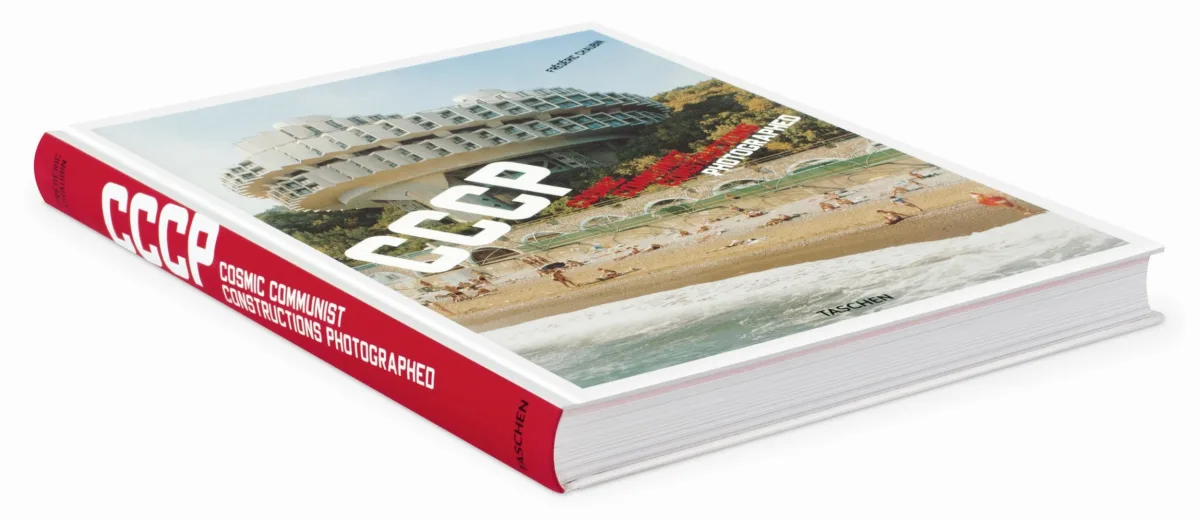1 / 7
XL
XL books are at least 34 cm (13.4 in.) high, with the exception of landscape-format titles
Frédéric Chaubin. CCCP. Cosmic Communist Constructions Photographed
70Edition: Multilingual (English, French, German)Availability: In StockFrédéric Chaubin’s Cosmic Communist Constructions Photographed features 90 Soviet buildings throughout the former USSR, each built between 1970 and 1990. It is a journey through time. With local exoticism, outlandish ideas, and a puzzle of styles, these weird and wonderful buildings are unearthly reminders of a fallen ideology.
Hardcover, 10.2 x 13.4 in., 5.87 lb, 312 pages
“The wonderfully titled CCCP is the perfect coffee table book for unrepentant Marxists.”
“...an eye-opening experience for those who assumed that Soviet architecture died with the rise of Stalin.”
“…one of the most splendid of recent architecural publications and a revelation.”
“This book is an extraordinary achievement, and Chaubin’s haunting photographs only improve with looking.”
“A revolutionary read.”
“Soviet brutalism is not something traditionally thought of as beautiful, but Frederic Chaubin’s stunning photographs should go some way to changing this. This book is a bold foray into an architectural period that is barely documented, either in the former Soviet Union or the west.”
XL
XL books are at least 34 cm (13.4 in.) high, with the exception of landscape-format titles

Frédéric Chaubin. CCCP. Cosmic Communist Constructions Photographed
70Brutalist Beauties
Architectural remnants of the USSR
Elected the architectural book of the year by the International Artbook and Film Festival in Perpignan, France, Frédéric Chaubin’s Cosmic Communist Constructions Photographed explores 90 buildings in 14 former Soviet Republics. Each of these structures expresses what Chaubin considers the fourth age of Soviet architecture, an unknown burgeoning that took place from 1970 until 1990.
Contrary to the 1920s and 1950s, no “school” or main trend emerges here. These buildings represent a chaotic impulse brought about by a decaying system. Taking advantage of the collapsing monolithic structure, architects went far beyond modernism, going back to the roots or freely innovating. Some of the daring ones completed projects that the Constructivists would have dreamt of (Druzhba Sanatorium, Yalta), others expressed their imagination in an expressionist way (Palace of Weddings, Tbilisi).
A summer camp, inspired by sketches of a prototype lunar base, lays claim to Suprematist influence (Prometheus youth camp, Bogatyr). Then comes the “speaking architecture” widespread in the last years of the USSR: a crematorium adorned with concrete flames (Crematorium, Kiev), a technological institute with a flying saucer crashed on the roof (Institute of Scientific Research, Kiev), a political center watching you like Big Brother (House of Soviets, Kaliningrad).
In their puzzle of styles, their outlandish strategies, these buildings are extraordinary remnants of a collapsing system. In their diversity and local exoticism, they testify both to the vast geography of the USSR and its encroaching end of the Soviet Union, the holes in a widening net. At the same time, they immortalize many of the ideological dreams of the country and its time, from an obsession with the cosmos to the rebirth of identity.
Contrary to the 1920s and 1950s, no “school” or main trend emerges here. These buildings represent a chaotic impulse brought about by a decaying system. Taking advantage of the collapsing monolithic structure, architects went far beyond modernism, going back to the roots or freely innovating. Some of the daring ones completed projects that the Constructivists would have dreamt of (Druzhba Sanatorium, Yalta), others expressed their imagination in an expressionist way (Palace of Weddings, Tbilisi).
A summer camp, inspired by sketches of a prototype lunar base, lays claim to Suprematist influence (Prometheus youth camp, Bogatyr). Then comes the “speaking architecture” widespread in the last years of the USSR: a crematorium adorned with concrete flames (Crematorium, Kiev), a technological institute with a flying saucer crashed on the roof (Institute of Scientific Research, Kiev), a political center watching you like Big Brother (House of Soviets, Kaliningrad).
In their puzzle of styles, their outlandish strategies, these buildings are extraordinary remnants of a collapsing system. In their diversity and local exoticism, they testify both to the vast geography of the USSR and its encroaching end of the Soviet Union, the holes in a widening net. At the same time, they immortalize many of the ideological dreams of the country and its time, from an obsession with the cosmos to the rebirth of identity.
The photographer
Frédéric Chaubin was the editor-in-chief of the French lifestyle magazine Citizen K for twenty years. Since 2000, he has regularly published works on architecture, combining text and photography, and presented accompanying exhibitions and lectures. He approaches his architectural research through a historical lens. After his CCCP collection research, published in 2011, he has delved into the remains of the medieval world, with his TASCHEN title Stone Age. Ancient Castles of Europe.
Frédéric Chaubin. CCCP. Cosmic Communist Constructions Photographed
Hardcover, 26 x 34 cm, 2.66 kg, 312 pagesISBN 978-3-8365-2519-0
Edition: Multilingual (English, French, German)Download product images here
4.9
Amazing book
September 1, 2023
An essential treasure for those who love architecture and East Europe. The XL size makes the book even greater.The soviet myth
November 7, 2021
The book is not just a collection of impressive photos. Divided into chapters, enriched with a text, combining photos of the time with recent photos, it clearly restores the impression of the myth sustained beyond all reasonableness, of the grandeur of Soviet ideology. An unusual, rich, poignant, magnificent book.Rivelazione
November 6, 2021
Francamente non conoscevo queste opere, alcune delle quali dei veri e propri gioielli a mio avviso, presenti nella fredda unione sovietica. Libro ispiratore e formativo.Beautiful
November 5, 2021
The book is very interesting to look at all these photos - there are pictures of Soviet architectural buildings of different periods and styles, scattered in different countries , which previously formed part of the Soviet Union. I really like the aesthetics of the architecture displayed in the book. Overall really cool.Excellent
November 2, 2021
When you love abstract forms and photography, this is your thing. Love it! Would love to see this in real life...






